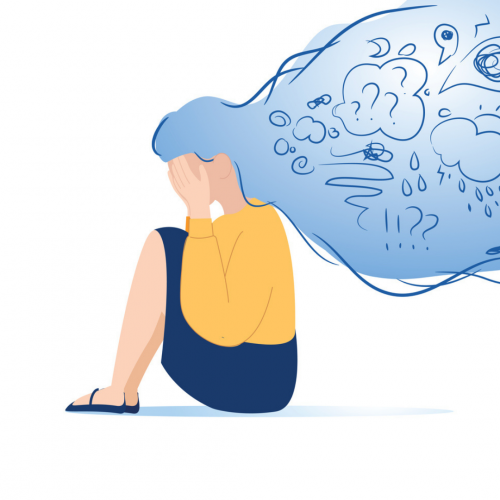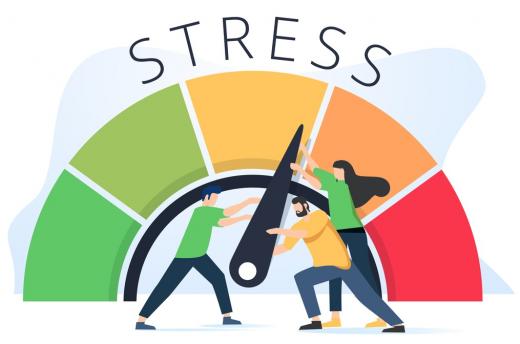Follow these links to learn more about common mental health and behavioral health issues and the options that are available to you.


Anger Issues
Anger and rage issues can cause lasting damage to relationships at home and at work. Whether your anger has led to violence or not, anger management counseling can help you control your anger.
- Identify ways anger affects your life negatively
- Rate the level and severity of your anger
- Learn techniques for managing your anger
- Define anger and identify myths about anger
- Identify the factors that trigger your anger
- Identify ways anger has affected your relationships
- Understand the effect of abusive behavior on victims
To schedule an individual counseling session to address anger issues, contact The Village Family Service Center.
Anxiety
Anxiety is a part of our everyday lives. When it becomes overwhelming, constant, or interferes with everyday activities, you may have an anxiety disorder. You might feel anxious when faced with a problem at work, before taking a test, or making an important decision. Anxiety and depression are closely linked and it can sometimes be difficult to identify between the two.
Anxiety disorders are real, serious medical conditions – just as real and serious as physical disorders such as heart disease or diabetes. Anxiety disorders are the most common mental disorders in the United States.
Types of Anxiety
-
Panic Disorder: Sudden feelings of terror when there is no real danger. Feelings of losing control or having physical symptoms, such as fast heartbeat are common.
-
Social Anxiety Disorder: Also called social phobia, this is when there are feelings of overwhelming worry and self-consciousness about everyday social situations. People tend to fixate about others judging them, embarrassing them, or ridiculing them.
-
Specific phobias: Feelings of intense fear of a specific object or situation, such as heights or flying. The fear goes beyond what's appropriate and may cause you to avoid ordinary situations.
-
General Anxiety Disorder: Feelings of excessive, unrealistic worry, and tension with little or no reason.
Anxiety symptoms
Symptoms tend to cross between the different disorders, but a few common ones are:
- Panic, fear, and uneasiness
- Sleep problems
- Not being able to stay calm and still
- Cold, sweaty, numb or tingling hands or feet
- Shortness of breath
- Dry mouth
- Nausea
- Tense muscles
- Dizziness
Managing Symptoms
These tips may help you control or lessen your symptoms:
- Cut down on foods and drinks that have caffeine, such as coffee, tea, cola, energy drinks, and chocolate. Caffeine is a mood-altering drug, and it may make symptoms of anxiety disorders worse.
- Eat right, exercise, and get better sleep. Brisk aerobic exercises like jogging and biking help release brain chemicals that cut stress and improve your mood.
- Sleep problems and anxiety disorder often go hand in hand. Make getting good rest a priority. Follow a relaxing bedtime routine.


Attachment Disorder
Attachment issues may develop when the necessary emotional connection between a caregiver and a child is disrupted in the early, most vulnerable, years of a child's life. This break in attachment can be due to physical abuse, emotional abuse, sexual abuse or neglect. Other times it is due to multiple foster care placements or serious prolonged illness of the child or caretaker.
Children with attachment issues may:
- not trust caregivers or adults in authority
- have extreme control problems
- not develop a moral foundation; little or no empathy, remorse, conscience or compassion for others
- lack the ability to give and receive genuine affection or love
- resist all efforts to nurture or guide them
- lie, steal, cheat, and manipulate
- be impulsive and lack self-control
- be destructive, cruel, argumentative, and hostile
Some experts believe that the vast majority of "kids who kill" suffer from undiagnosed attachment disorders. The Village Attachment Program works with these children to develop secure attachments.
Therapy for Attachment Disorder
"The therapy, although at times extremely exhausting and difficult, was done in a gentle and nurturing way. More progress was made (with The Village) than in 2½ years of conventional therapy."
Trained therapists conduct a full assessment to determine your child's needs.
Outpatient therapy consists of weekly therapy sessions. The sessions involve both parents and children and are geared to improve the child's emotional functioning and to iron out problems between child and parent. The sessions also help a child deal with early anger at having been abandoned or abused. The parents (biological, adoptive or foster parents) are often the target of the child's present anger and are present to help the child build a sense of trust.
The best indicator of success of treatment comes from the parents:
"I believe that this therapy is the only thing that will truly help our daughter to accept love and sincerely give love back. I believe this work will allow her and our family to have a bright and happy future."
Autism Spectrum Disorder
Research by the Centers for Disease Control and Prevention indicates that 1 in every 36 American children has been identified as having autism spectrum disorder (ASD). While researchers try to pursue effective treatment options, families affected must try to understand the condition and their children. The following definitions and tips can help us better understand autistic children. (Note: If you believe your child may be dealing with ASD, please contact The Village to arrange an appointment.)
Autism is a spectrum disorder. This means a person can be affected very mildly or very severely, with many points in between. The person affected may have very high intelligence or may have developmental or cognitive delays, also with many degrees of ability in between. This also means there are many different therapeutic and educational approaches that may be helpful.
When supporting a child or family member with either a suspected or diagnosed autism spectrum disorder, keep the following things in mind.
ASD is a lifelong neurological condition
This means it has to do with the way the person's brain and body are "wired." As such, it is not the result of bad parenting or a child who is merely acting naughty or difficult. There are many theories and debates regarding environmental toxins, vaccinations, the role of diet on ASD, and research suggesting a genetic component. However, the desired outcome for most therapies and educational intervention still remains-to increase the individual's level of functioning within their community, rather than providing a cure.
Early intervention is crucial
Autism can be a scary word to hear, but one thing all of the experts agree on is that early identification and intervention is critical. Also, any intervention program needs to be a team approach. Such a team may include many professionals; but will often include an occupational therapist, a speech clinician, educators, and a mental health professional.
Sensory overload can result in meltdown
To many, a meltdown looks like a tantrum or possibly as someone just “shutting down” or tuning-out. Either way, it is a form of communication about the person’s inability to cope with any additional information or input at that moment in time. People with ASD often experience sensory input as bothersome when everyone around them seems able to tune it out or otherwise not notice it at all. This difference in experiencing and processing sensory input from all of the senses; including touch, taste, and movement can create substantial difficulties for the individual with ASD and their family. This can result in extreme food preferences, rigidity in clothing choices, and meltdown, especially in public places. For some individuals, a simple trip to the store is torture. Finding an occupational therapist trained in sensory processing disorders to be a member of the multi-disciplinary team can be of great assistance.
Be blunt, but kind, when speaking to someone with ASD
People with ASD are often described as “concrete thinkers.” This means they often take what people say at face value, and do not interpret hidden agendas or meanings resulting in difficulty understanding idioms, metaphors, and other sayings that use figurative language.
Speaking things exactly as you mean them without hidden meaning is key to effectively communicating with someone who has ASD. It is important to note this is not an issue of intellect; it is related to the way the brain is wired although these skills can be developed if they are taught to the individual. Speech clinicians and some mental health professionals can help to teach these communication and social skills to individuals with ASD so they can also communicate more effectively in their communities.
Think visually
This means supplementing instructions with visual representation of what you are trying to communicate. This might include visual schedules with pictures or symbols to prepare a child for what will happen and what is expected, or possibly using pictures or symbols to further clarify what is being explained. Younger children may need to use actual photos. For older or higher functioning individuals, you may use written words or line drawings to make information more visual. Also, since people with ASD often require more time to process verbal information, the use of visuals further augments their understanding of information.
You don't have to go it alone. Professionals at The Village can help provide support to family members, aid in teaching appropriate coping and social skills, provide therapeutic support, and assist families in charting a course for treatment.

Relationship Conflict
Every relationship has its ups and downs. Even the closest and healthiest relationships experience moments of tension. When two people spend a lot of time together, they are bound to disagree from time to time. The mere fact that you fight with your partner isn’t a sign that there is real trouble in your relationship. In fact, when handled properly, conflict can improve your relationship. If you never fight and never talk about your problems, you will never solve them.
Marriage or couples counseling, available at all Village locations, can help you and your partner communicate more effectively, navigate challenges, and strengthen your bond. The University of Texas at Austin provides the following 8 ground rules for fighting fair:
- Remain calm. Try not to overreact to difficult situations. Your partner is more likely to consider your viewpoint if you remain calm.
- Express feelings in words, not actions. If you start to feel so angry or upset that you feel you may lose control, take a “time out.” Take a walk, do some deep breathing, play with the dog, write in your journal – whatever works for you.
- Be specific about what is bothering you. Vague complaints are hard to work on. Deal with only one issue at a time. Don’t introduce other topics until each is fully discussed. This avoids the “kitchen sink” effect where people throw in all their complaints while not allowing anything to be resolved.
- No hitting below the belt. Attacking areas of personal sensitivity creates an atmosphere of distrust, anger, and vulnerability. Avoid accusations. Talk about how your partner’s actions or words made you feel. If you make accusations, your partner will be likely to defend their actions rather than focus on understanding you.
- Try not to generalize. Avoid words like “never” or “always.” Such generalizations are usually inaccurate and will heighten tensions. Avoid make believe. Exaggerating or inventing a complaint – or your feelings about it – will prevent the real issues from surfacing.
- Stick with the facts and your honest feelings. Don’t stockpile. Storing up lots of grievances and hurt feelings over time is counterproductive. It’s almost impossible to deal with numerous old problems for which recollections may differ. Try to deal with problems as they arise.
- Avoid clamming up. Positive results can only be attained with two-way communication. When one person becomes silent and stops responding to the other, frustration and anger can result. However, if you feel yourself getting overwhelmed or shutting down, you may need to take a break from the discussion. Just let your partner know you will return to the conversation as soon as you are able and then don’t forget to follow-up.
- Establish common ground rules. You may even want to ask your partner to read and discuss this information with you. When both people accept positive common ground rules for managing a conflict, resolution becomes much more likely.
By dealing with conflicts constructively, you can gain a better understanding of your partner and arrive at a solution that works for both of you.
Fair Fighting: Step by Step
- Before you begin, ask yourself, “What exactly is bothering me? What do I want the other person to do or not do? Are my feelings in proportion to the issue?”
- Know what your goals are before you begin. What are the possible outcomes that could be acceptable to you?
- Remember that the idea is not to win but to come to a mutually satisfying solution to the problem.
- Set a time for a discussion with your partner. It should be as soon as possible but agreeable to both persons. Springing a conversation on someone when they are unprepared may leave them feeling like they have to fend off an attack. If you encounter resistance to setting a time, try to help the other person see that the problem is important to you.
- State the problem clearly. At first, try to stick to the facts; then, once you’ve stated the facts, state your feelings. Use “I” messages to describe feelings of anger, hurt, or disappointment. Avoid “you” messages such as, “you make me angry…”; instead, try something like, “I feel angry when you…”
- Invite your partner to share his or her point of view. Be careful not to interrupt, and genuinely try to hear his or her concerns and feelings. Try to restate what you heard in a way that lets your partner know you fully understood, and ask your partner to do the same for you.
- Try to take the other’s perspective; that is, try to see the problem through his or her eyes. The opposing viewpoint can make sense to you, even if you don’t agree with it
- Propose specific solutions, and invite the other person to propose solutions, too. Discuss the advantages and disadvantages of each proposal.
- Be willing to compromise. Allowing the other person only one option will make it difficult to resolve the concern.
- When you reach an agreement on a way forward, celebrate! Decide together on a time to check in, discuss how things are working, and make changes to your agreement if necessary. If no solution has been reached regarding the original problem, schedule a time to revisit the issue and continue the discussion.

Workplace Conflict
While conflict is a normal part of any social and organizational setting, the challenge of conflict lies in how one chooses to deal with it. Concealed, avoided or otherwise ignored, conflict will likely grow into resentment, create withdrawal or cause factional disagreement within an organization.
So, what creates conflict in the workplace? Opposing positions, competitive tensions, power struggles, ego, pride, jealousy, performance discrepancies, compensation issues, just someone having a bad day, etc. While the answer to the previous question would appear to lead to the conclusion that just about anything and everything creates conflict, the reality is that the root of most conflict is either born out of poor communication or the inability to control one’s emotions.
Sources of Conflict
There are many causes or reasons for conflict in any work setting. Some of the primary causes are the following.
- Poor Communication: Different communication styles can lead to misunderstandings among employees or between employee and manager. Lack of communication drives conflict "underground."
- Different Values: Any workplace is made up of individuals who see the world differently. Conflict occurs when there is a lack of acceptance and understanding of these differences.
- Differing Interests: Conflict occurs when individual workers "fight" for their personal goals, ignoring organizational goals and organizational well-being.
- Scarce Resources: Too often, employees feel they have to compete for available resources in order to do their job. In a resource scarce environment, this causes conflicts – despite awareness of how scarce resources may be.
- Personality Clashes: All work environments are made up of differing personalities. Unless colleagues understand and accept each other’s approach to work and problem-solving, conflict will occur.
- Poor Performance: When one or more individuals within a work unit are not performing.
Managing Conflict at Work
Don’t be a conflict-avoider.
Difficult interpersonal workplace problems won’t disappear by ignoring them; they’ll only get worse. Chronic conflict-avoiders will end up losing the respect of their co-workers.
Maintain the moral high ground.
Don’t lose control, pull rank, or give up the moral high ground. Calm control is a more effective position to negotiate from.
Don’t think in terms of winning.
Get closure and move ahead – the sooner, the better.
How We Can Help
We have many counselors who can help you problem solve and manage workplace conflicts. For more information or to make an appointment to see a counselor, contact The Village Family Service Center.
Depression
Feeling sad, alone, or discouraged is a normal reaction to a major loss or disappointment. However, a blue period that won’t let up or keeps coming back may be a sign of depression. Depression, an illness that involves changes in the brain's chemicals, affects how you feel, think, and act, and can leave you feeling worthless and unable to cope.
It is important to treat depression because early treatment may keep depression from becoming more severe or chronic. The risk of suicide increases when depression is not treated, and treatment can prevent recurrences of depression.
Signs of Depression
There are times where we can feel sad or discouraged but if these signs last longer than a couple weeks, it may be depression. There are many different symptoms that one might experience, here are a few common ones:
- Feelings of sadness, emptiness, or hopelessness
- Irritability or restlessness
- Having little interest or pleasure in doing things you used to enjoy
- Sleep issue including lack of sleep or feeling tired all the time
- Fixating on past failures or self-blame
- Weight gain or loss
- Loss of energy
- Suicidal thoughts or attempts
Treatment
Effective treatments for depression include individual counseling and group therapy. The Village’s professional counselors can make referrals to a psychiatrist or physician if they think an anti-depressant medication might be helpful.


Early Childhood Mental Health
It's not just adults who face struggles; kids can face obstacles too. The emerging field of early childhood mental health is finding that even very young children can have impaired mental health development. Identifying these issues and intervening right away can significantly impact a child's development and relationships. This is good news for parents who know something is wrong with their young child, but can't find help for them until they start school.
The Village Family Service Center provides early childhood mental health diagnosis and treatment. Services are generally covered through insurance – however, in some cases grant dollars can be accessed for services not fully covered.
How do I know if my child has mental health issues?
If you are uneasy about your child's behavior and development, the first step is to have your child undergo a comprehensive mental health assessment. Village staff is trained to provide mental health assessments for children ages birth to 5.
Some things to watch for in deciding if your child might have mental health issues:
- A loss of skills – for instance, a child who once could talk or verbalize words now has regressed and can no longer talk or verbalize as before.
- A traumatic, scary or dangerous experience followed by a change in behavior or sleep patterns.
- Significant change in eating, sleeping, or mood (such as excessive crying) that lasts longer than a couple weeks.
- Difficult behavior at home, daycare, or preschool. For example, the child is kicked out of daycare.
- Difficulty adapting to a change such as the loss of someone significant, a move to a new home, daycare or preschool.
- Concerns about your child's behavior, emotional expressions, or social-emotional development, expressed by people close to the child.
How much will it cost?
The Village is providing early childhood mental health services through a grant from the state of Minnesota, so the costs are covered for Minnesota children and their families who are uninsured or underinsured. Other families can access Medical Assistance or health insurance. When you schedule an appointment, we will help identify the appropriate payor and handle the paperwork for assuring payment.
Eating Disorders
Anorexia nervosa, bulimia nervosa, and binge eating disorder can have devastating effects. Each year millions of people in the United States are affected by serious and sometimes life-threatening eating disorders. The vast majority of those afflicted with eating disorders are adolescent and young adult women. Researchers have found that stringent dieting can play a key role in triggering eating disorders.
The consequences of eating disorders can be severe. Anorexia nervosa can lead to death from starvation, cardiac arrest, other medical complications, or suicide. Fortunately, increasing awareness of the dangers of eating disorders – sparked by medical studies and extensive media coverage of the illness – has led many people to seek help.
In research supported by the National Institute of Mental Health (NIMH), scientists have found that people with eating disorders who get early treatment have a better chance of full recovery than those who wait years before getting help.
More about Eating Disorders and their Treatment
Anorexia Nervosa
People who intentionally starve themselves suffer from an eating disorder called anorexia nervosa. The disorder, which usually begins in young people around the time of puberty, involves extreme weight loss – at least 15 percent below the individual's normal body weight. Many people with the disorder look emaciated but are convinced they are overweight. Sometimes they must be hospitalized to prevent starvation.
Bulimia Nervosa
People with bulimia nervosa consume large amounts of food and then rid their bodies of the excess calories by vomiting, abusing laxatives or diuretics, taking enemas, or exercising obsessively. Some use a combination of all these forms of purging. Because many individuals with bulimia "binge and purge" in secret and maintain normal or above normal body weight, they can often successfully hide their problem from others for years.
Binge Eating Disorder
An illness that resembles bulimia nervosa is binge eating disorder. Like bulimia, the disorder is characterized by episodes of uncontrolled eating or binging. However, binge eating disorder differs from bulimia because its sufferers do not purge their bodies of excess food.


Grief and Loss
Feelings of grief and loss can come from a variety of experiences including death of a loved one, loss of a career or role you played in an organization, loss of a relationship, and more. No matter the source of the intense, painful feelings that come from grief, they can be very difficult to deal with. Here are some tips on coping with grief:
Acknowledge Your Feelings
Name and validate your emotions to help yourself come to terms with what is going on in your life and in your mind. You cannot move beyond painful feelings if you are avoiding them. Try writing down what happened and how it makes you feel. This can be a reality check that helps you see you are not flawed, but that your circumstances are difficult. Acknowledging the importance of the loss and giving yourself a break can help you heal.
Practice Self-Care
Grief can feel like it consumes you completely. After a difficult loss, you may find yourself struggling with personal hygiene, eating well, and doing things that used to bring you joy like hobbies and spending time fostering your relationships. One way to help yourself during a grieving period is to continue to take care of yourself. This helps restore a sense of normalcy, and it can actually help you deal with your feelings.
Activities such as meditation, physical exercise, or connecting with a friend can help you through difficult feelings. It's useful to take your mind off the pain and give yourself a positive experience instead. These types of activities will help retrain your brain to be more optimistic and focus on the good in your life.
Be Kind to Yourself
It’s important to not get caught up in blaming yourself during your grief process. Some people naturally gravitate toward self-blame when something goes wrong, but this is not helpful after loss. You deserve the same kindness and understanding you would offer a friend. Don’t inflict negative messages on yourself that will only make you feel worse.
Practice positive self-talk. Remind yourself that there will be a time when you don’t feel this way. You just need to allow yourself the space to get there. You need time to heal and properly feel your feelings.
Talk to Someone
Dealing with grief on your own can be difficult and oftentimes impossible. Seek support from people who have been through a similar loss, who are in the exact same situation, or who you trust and feel comfortable talking to. If you keep your feelings inside and don’t tell anyone about them, you can start spiraling. Seeking the help of others can help lift you up.
Friends and family members who are good listeners can engage in meaningful conversations about your pain. If you feel you’re not quite getting what you need, you can talk to a therapist, who, in many ways, is a professional listener. Therapists are trained to help when you are struggling with loss and grief. They can offer you tools to help you cope and aid you in working through painful feelings. Remember, what you’re experiencing is very real, and you don’t have to go it alone.
Grief in Children
Just as death is a fact of life, it’s a fact that children grieve. "Any child old enough to love is old enough to mourn,” says Alan Wofelt, author of “Companioning the Grieving Child." But many of us prefer to avoid the topics of death and grief with children. Adults especially want to do that with children because they see their role as that of protector. They want to shield children from pain, when the best way to help them mourn the loss of someone they love is to walk beside them as they move through the pain.
Grieving at Every Age
How children grieve varies depending on the child’s age, personality, and circumstances. Infants and toddlers may not understand death, but they do know that someone is missing from their world. And they sense the grief of the people around them. They may cry more than usual, sleep more or less, or change their eating patterns.
Like infants and toddlers, older children may not understand the finality of death, but they understand that something has changed. Fear is a common grief reaction for children. They may worry it could happen to someone else close to them. This fear often makes children clingy or revert to previous behaviors like wetting the bed, wanting to sleep with their parents, or being afraid to be away from their parents.
Teenagers grieve much like adults by feeling sadness, guilt, and regret. Yet grief is complicated in teenagers because adolescence is already such a confusing and chaotic time in their lives. Because teenagers understand death, they are more frightened than younger children. Death makes teens aware of their own mortality. It makes them curious and changes the way they think about life, positive or negative.
“Teenagers often withdraw, pretend they are not affected, and act as though death cannot touch them. Those feelings of immortality and that attitude of disinterest can carry them through the early days or months of grief – but eventually, everything catches up with them. They soon realize that even they must stop to grieve and find a way to learn to live within a new kind of framework,” Mary DeTurris Poust writes in her book, “Parenting a Grieving Child.”
Even when adults are there for their kids, the journey through grief is not without detours and dead ends along the way.
Walking with Your Child Through Grief
You won’t be able to protect your children from the sadness and confusion that accompanies grief, but you can walk beside them as they go through it. Here are some tips for facilitating the grieving process for your children.
Help children understand what happened
“It is up to us parents to help them make sense of the chaos and to give them the basic information they need to process the event. Tell them the truth and don’t use confusing terms for death. You don’t need to give them the gory details about the death, but you have to give them the true story. Ninety-nine percent of the time they know the real story anyway. Not telling them the truth breaks your trust with them,” Poust writes.
Ask children to tell you what they know, and then fill in the missing details in terms they can understand. Adults who are willing to talk openly about the death help children understand that grief is a natural feeling when someone loved has died. Children need adults to confirm that it’s all right to be sad and cry, and that the hurt they feel now won’t last forever.
Maintain a routine
Regardless of their age, children need to be able to fall back on familiar routines. This won’t always be easy, especially at the beginning when you’re preparing for the funeral and family and friends are coming and going. But get back to a routine as soon as possible. Also continue to enforce your family rules. Sometimes parents feel bad for their children, especially if they’ve lost their other parent, so they become more flexible and some kids will take advantage of this.
Allow children to attend the funeral
Don’t force them to attend, but give them the option and if the person who died is close to them, involve them in the preparations as much as possible. Rituals are an important part of grief, and the ways to involve kids in the funeral are endless. Older children can write something to read at the funeral, or give it to an adult to read. Young children might want to draw pictures and put them in the casket. Maybe the grandchildren have a favorite song and want to sing at the funeral.
Give children the freedom to grieve in their own time and their own way
Kids, especially young kids, instinctively know they can’t handle all the pain at once, so they often experience it in bursts. They feel sad and cry, and then they go out and play like nothing has happened. Parents worry about their children when they do this, but grief experts assure parents that children will grieve as much as they need to, as long as they are allowed to do so.
The grief process is individual. If your children don’t want to talk about the death, don’t force them. Find ways for your children to commemorate the person who died. This could be a special piece of jewelry, a homemade scrapbook or a memory book, where you can write down memories or draw pictures.
Don’t be afraid to cry in front of your children
How you grieve will teach your children what is acceptable and what’s not. Reassure kids that it’s okay to cry by saying to them something like, “I might start crying when we talk about this, but that’s okay.” They are more apt to be comfortable crying in front of you if they’ve seen you cry.

When a Child’s Pet Dies
Some parents may want to protect their children from the death of a pet by telling them it ran away, or by getting a new pet right away to distract them. Still others actually replace the pet in hopes that their children won’t know the difference. (Obviously this would be tough to do with a dog or cat, but it might work with a gerbil or a fish!)
Whether it works or not, grief experts don’t recommend trying to shield our children from the death of their pets. Losing a pet is often the first introduction children have to death, and it can set the tone for their comfort with death and grieving throughout their lives.
Allowing our children to grieve the little losses, like losing a pet or not making the sports team, will affect their ability to accept and grieve the significant losses they will inevitably face. So when your pet dies, be honest with your children and allow them to grieve its loss. The loss of a pet is a good place to start learning about the circle of life and death – and to practice the grieving that goes with it.
When it’s Time to Seek Professional Help
Watch for changes in your child’s behavior to determine if they need professional help to get through the grieving process. Are they eating? How are they sleeping at night? How are their grades? Have they shown any difference in how they are interacting, or not interacting, with friends? In teenagers, also watch for self-destructive behaviors like drugs, alcohol, cutting, risk-taking, driving too fast, and acting like they feel invincible.
If you have any concerns about your child, seek out a support group or make an appointment with a counselor.
A New Normal
Death may be an event, but the grief that follows is a process – a process that continues for the rest of a person’s life. It’s not something you can be over and done with, and life will never go back to how it was before the death.
When a child loses a loved one, they not only lose the person, they also lose their vision of the future with that person in it. Think about the things that person did for your child when they were alive to understand how their life has been impacted by the loss. Were they the person who tucked them in every night? Or played catch with them? Or took them to the park?
Let your children know you may not know what you are feeling, but you are trying to understand. Through grieving, children learn to adjust to a world without their loved one.

Infidelity in Relationships
Affairs and online relationships occur for similar reasons – usually because of problems in the primary relationship. People feel unappreciated, neglected, misunderstood, lonely, or they have lost passion, and as a result, they look for those losses to be fulfilled by someone else.
Affairs are a violation of trust in a relationship. Recovering from an affair as a couple is a difficult two-person job. A skilled counselor can help guide the couple in resolving the hurt and in taking steps to repair the relationship and rebuild trust.
The Internet has added a new layer to infidelity in the form of online affairs. Some people do not believe online relationships should be qualified as affairs; they believe they are harmless, and as such, are not a violation of trust in a relationship. Because relationships that occur via email or through chat rooms rarely, if ever, involve face-to-face contact, the individual engaging in the relationship may not see their behavior as problematic. They also don’t involve the risks of a typical affair. Individuals engaging in online relationships don’t have to worry about being seen in public, finding places and times to get together, risks of sexually transmitted disease or pregnancy, or unexplained absences
No external relationships are without risks, however. There is always the possibility that engaging in an affair, whether through email, chat or in person might increase the possibility of stalking, sexual assault, and other violations. In addition, online relationships can be electronically traced, thus, they are not foolproof.
Most important, external relationships can be damaging to the relationship you have with your partner. They typically involve some form of emotional attachment, and people are more likely to be critical of their partner if they have an emotional attachment to someone else. In addition, there is a tendency to withdraw from the current relationship and be less involved emotionally, physically, and otherwise. Online relationships may also make it easier to venture into having a traditional affair.
If you suspect a partner of engaging in such a relationship, it is generally more productive to focus on the specific behavior (i.e., online flirtation, chat room sexual talk, etc.), rather than the lying and deception.
Discuss your concerns in a calm, rational manner and in such a way that increases the likelihood you will be heard. Focus on your feelings, not the deception. It is important the other person not feel attacked or a confrontation is likely to occur. Being calm and rational also increases the chances of rebuilding trust and healing the pain.
If you need help healing your relationship from the wounds caused by your or your partner's infidelity, online or in person, contact The Village Family Service Center.
Perinatal Mental Health
Perinatal mental health is mood or anxiety disorders (PMADS) that occur anytime during pregnancy through the first year postpartum. These disorders include depression, anxiety, OCD, trauma, bipolar disorder, panic disorder, and psychosis. 1 in 7 women experience more significant symptoms of depression or anxiety during or after childbirth. These disorders usually do not resolve without treatment.
Parents of all ages, cultures, ethnicities, and income levels can develop a perinatal mood or anxiety disorder. Without appropriate intervention, poor maternal mental health can have long-term, adverse implications for mother, child, and family.
Screening and early intervention can protect the well-being of the mother, baby, and the entire family. Recognizing symptoms and reaching out as soon as possible can help prevent a worsening of symptoms and help you work towards recovering and feeling supported and empowered as a parent.
Symptoms of perinatal mental health
- Feeling depressed or hopeless
- Lack of interest in baby
- Trouble concentrating
- Feeling anxious/panicky or angry/irritable
- Not able to sleep when baby sleeps
- Extreme worries or fears (including for the health and safety of the baby)
- Flashbacks of pregnancy or delivery
- Avoiding things related to delivery
- An urge to repeat certain behaviors to reduce anxiety
- Needing very little sleep while still functioning
- Seeing images or hearing sounds that others cannot see/hear
- Scary and unwanted thoughts, including thoughts of harming yourself or the baby
The journey of motherhood is not always an easy one and can come with its own set of difficulties. But help is available. You are not alone, and you are not to blame. Maternal anxiety and depression are the most common complications of childbirth. With help, you will be well.


Stress and Stress Relief
Jeremy, a 45-year-old mechanical engineer, husband, and father of three young boys, was used to working 10-hour shifts, followed by errands after work and various extracurricular obligations involving his children. Mondays were basketball nights, Tuesdays were karate, Wednesdays – church night. Thursdays were bowling night with his buddies. He could forget time off on the weekends, thanks to yard work, paying bills, and any other chores that needed to be taken care of.
By Friday, he was exhausted. He usually collapsed in front of the television with a cold beer, rubbing his sore neck and massaging his pulsating head. He was all worked out, parented out, and he just wanted to be left alone. Sometimes he even took his need for some relaxation out on the kids by yelling at them for being too loud or not listening.
Jeremy’s relationship with his wife became strained as well. “You’re not there for me anymore,” she said.
“Well, you try to work 50 hours a week, take the kids to all their activities, and try to have energy for you,” he said. Jeremy took out some of his emotions on the people he loved the most. To make matters worse, there were rumors of layoffs at the office, his father was sick with cancer, and he was drinking more than just a couple beers a night in an effort to self-medicate.
Jeremy was stressed.
For many of us, the above scenario is all too familiar. Even with the best of intentions, work, family, and other obligations can take their toll over time and cause acute or chronic stress.
Stress is something we all deal with every day. Sometimes that stress is "good" stress, which motivates us to action and keeps us safe. And then there is bad stress – extreme, long-term, draining on the body and damaging to our emotional wellness.
Signs of stress show up in many areas. Though stress reactions vary by person to person, how you react and cope with the stress is important.
Physical reactions to stress include:
- insomnia
- nightmares
- fatigue
- nervous energy
- appetite changes
- neck or back pain
- headaches
- lightheadedness
- high blood pressure
Emotional reactions to stress include:
- irritability
- anger
- anxiety
- helplessness
Not only are there physiological and behavioral consequences of a too-stressed mind and body, but your productivity at work can suffer as well. Stress can affect productivity in several ways, including:
- inability to concentrate
- increased incidence of errors
- memory lapses
- increased absenteeism
- tendency to overwork
In response to those stressors, our bodies constantly seek to maintain a balance between our reactions to the challenges we face and our need to recuperate from those challenges. When we don’t give ourselves enough time to recuperate, stress symptoms can become chronic and wreak havoc on the mind and body. In fact, research shows a likely connection between stress and many common diseases, including heart disease and obesity.
Stressed out people are more likely to partake in risky behaviors like drinking, smoking and driving over the speed limit, thus increasing their chances of illness and injury.
Unfortunately, many of us don’t realize we’re truly stressed out. The signs of excessive stress often go unnoticed. We can talk ourselves out of recognizing or dealing with the pain we're experiencing.
But we need to take the time to recognize physical pain and find ways to cope and overcome it, as it is often an early indicator that things are out-of-balance in our lives. Upper body pain in the neck, shoulders, arms, and head typically indicate stress and anxiety. Slow down, breathe, and take some time to reflect on what is going on in your life and how you are reacting to it. Chest pains or fainting are signs of a potentially serious medical condition; see a physician immediately if you experience these symptoms.
Tips to relieve acute and chronic stress:
- Breathe deeply from the abdomen, and recognize when your breath shallows; this indicates inadequate oxygen intake and could increase feelings of stress and anxiety
- Exercise regularly; try yoga to learn extra relaxation techniques
- Do something you enjoy, like going to a movie, eating an ice cream cone, reading a book
- Listen to music
- Talk to a friend or loved one, or even talk to yourself to help process a stressful situation
- Maintain a healthful diet full of fruits and veggies
- Sleep
- Laugh often
Over time the signs and symptoms of traumatic stress usually lessen. If your stress reactions do not lessen or reactions interfere with your ability to carry on your life normally, counselors at The Village Family Service Center can help you find ways to deal with and lessen your stress level. Our counselors have training in EMDR and other trauma-focused therapy models, Cognitive Behavioral Therapy, and Family-Based therapies that are effective in bringing balance back to your life.
Trauma
Everyone struggles in life at one time or another, and life’s journey has many ups and downs, twists and turns. Traumatic experiences often involve a threat to life or safety, but any situation that leaves you feeling overwhelmed and isolated can be traumatic, even if it doesn’t involve physical harm. It’s not the objective facts that determine whether an event is traumatic, but your subjective emotional experience of the event. Remember, trauma is an injury that happens to us.
Our trained professionals have experience helping clients who have experienced trauma, just like Ellie.
Traumatic events can be defined as experiences that put either a person or someone close to them at risk of serious harm or death. These can include:
- Road accidents
- Violence/prolonged abuse
- Natural disasters
- Serious illnesses
What happens when you experience a traumatic event?
When you experience a traumatic event, your body’s defenses take effect and create a stress response, which may make you feel a variety of physical symptoms, behave differently and experience more intense emotions. Some symptoms that may occur are:
- Raised blood pressure
- Increased heart rate
- Increased sweating
- Reduced stomach activity (loss of appetite)
This is normal. Directly after the event people may also experience shock and denial. This can give way over several hours or days to a range of other feelings such as sadness, anger and guilt. Many people feel better and recover gradually.
Getting help
If traumatic feelings continue, they can lead to more serious mental health problems, so contact us today to schedule an appointment.
Many of our clinicians have advanced training in specific trauma therapy models, including:
- Eye Movement Desensitization and Reprocessing (EMDR): EMDR involves reprocessing memories that have essentially become stuck in the brain. Sessions involve stimulating the hemispheres of the brain through visual, auditory, or tactile means until the memory is less disturbing and more positive thoughts and beliefs replace the prior negative thoughts and belief.
- Child-Parent Psychotherapy (CPP): CPP is a child-parent focused, evidence-based treatment for children ages birth to 6 years of age who have early trauma histories. The approach involves the primary care provider and child together in treatment.
- Trauma-Focused Cognitive Behavioral Therapy (TF-CBT): TF-CBT is an evidence-based treatment for children and adolescents impacted by trauma and their parents or caregivers. The child and caregiver learn new skills to process thoughts and feelings around the traumatic experience. TF-CBT can resolve a broad array of emotional and behavioral difficulties associated with trauma, including PTSD.

A Story of Childhood Trauma
Ellie’s pain was so deep she couldn’t see the bottom.
She’d done pretty well stuffing it, but now that she was a teenager, the images and memories from her childhood were starting to overflow, and she was terrified. She went from being on the honor roll to failing her classes. She started lying, running away, and cutting herself. When she became severely depressed and suicidal, Ellie was hospitalized. During her hospital stay, Ellie’s parents learned about The Village and set up an appointment for Ellie to see a Village therapist who specializes in the areas of trauma, and attachment disorder.
It took a while for Ellie to open up, but when she did it became very apparent just how much she had been through in her short life. And, as often happens with severe trauma and reactive attachment disorder, things got worse before they got better. She was hospitalized again. Her mom continued to meet with the therapist and together they worked to build for the time when Ellie would come home and they’d hopefully be able to move on as a family.
When Ellie did come home, she and her therapist went back to work. Through specialized interventions like Trauma-Focused Cognitive Behavioral Therapy, experiential therapy, and Eye Movement Desensitization and Reprocessing (EMDR), they began to make progress. Ellie began to see herself and her potential the same way everyone around her did. A year ago, Ellie wouldn’t speak to the therapist and now she was asking to see her. Therapy from The Village helped her to work through the pain and to step out of her past and into her present. Therapy also taught Ellie’s mom and dad how to parent Ellie in a way that works … for her and for them.
Ellie also worked with a Village therapist who came to the family’s home twice a week to help with the day-to-day issues of family living and school stressors. Ellie was in pain, angry, and afraid to feel the love of her family. As she continues to work through the memories and the pain, she feels her family’s love and isn’t terrified that love will hurt her.
Post-Traumatic Stress Disorder
When she was a child living at home with her parents, Barb learned to associate the sound of the phone ringing in the middle of the night with death. Because every time the phone rang during the night, it meant someone had died, and she remembers waking up to her mother wailing loudly. A ringing phone in the middle of the night became a stimulus that, for Barb, triggered unpleasant responses. When she left home for college, she continued to experience intense emotional and physical symptoms whenever the phone would ring after midnight.
“As I made my way to answer the phone,” Barb says, “I would experience panic-like symptoms – fear, rapid heartbeat, shallow breathing, and a sense of death. When I answered the phone it was either a wrong number or my college friends at a late night party.”
Even though she didn’t receive any death notifications in the middle of the night after she left home, it took several years for Barb's unpleasant reactions and symptoms to extinguish on their own.
While this story illustrates a small trauma and may lack the full criteria for Post Traumatic Stress Disorder (PTSD), it can help us understand how a trauma like war, accident, flood, rape or abuse can produce Post Traumatic Stress Disorder symptoms severe enough to impact a person’s ability to live a normal life.
When PTSD makes the news, it is usually related to soldiers returning from war, And, with good reason; 12.5 percent of soldiers returning from wars in the Middle East experienced symptoms severe enough to meet the clinical diagnosis of PTSD.
PTSD is not only a disorder of soldiers – 50 to 90 percent of us will experience a traumatic event in our lifetime. Less than 10 percent will suffer from full-blown PSTD, and while that doesn’t sound like a huge number, it is high enough that most of us will at one time or another be affected by a family member, friend or coworker who is suffering from PTSD.
PSTD is an anxiety disorder that may occur after a psychological and or physical trauma/event. Basically, PSTD results from a change in how we respond to stress. Stress hormones and body chemicals are affected by a trauma – and, because they play a part in relaying information to our brain, they can cause the brain to store information incorrectly. This can then result in an abnormal response to certain types of stress – the type of stress depends on the trauma experienced.
Symptoms of PTSD usually fit into one or more of three categories:
- Re-experiencing the traumatic event through flashbacks or intrusive memories triggered by events or actions with some similarity to the traumatic event.
- Avoidance of situations that may trigger flashbacks.
- Increased arousal. Exaggerated fear, anger and/or feelings of being threatened that can lead to fight or flight response.
Fortunately, PTSD can be treated. Treatment may include individual counseling, group counseling, Eye Movement Desensitization and Reprocessing (EMDR), exposure-type therapies, and medication. The first step in seeking treatment is to recognize you don’t have to live with negative responses significantly affecting your life. The second step is to seek help from a professional who can determine the type of treatment needed, and then use this treatment to help you reduce symptoms and increase coping skills.
The Village Family Service Center has counselors throughout North Dakota and Minnesota who can help people suffering from PTSD. For more information or to find the office nearest you, contact The Village Family Service Center.


Well-Being Counseling Services
Well-being counseling services are non-diagnostic counseling services that help clients proactively deal with life issues that if left unattended or unresolved could lead to more serious mental disorders or health problems. Web-based well-being counseling sessions focus on such things as communication problems, conflict resolution, emotional barriers to healthier lifestyle, stress reduction, and more. Our counselors will help you gain perspective, solve problems, and develop healthier ways to manage your life and relationships.
Contact The Village
To speak to a Village therapist about any of these or other mental heath concerns, please fill out the form below, or call 1-800-627-8220.